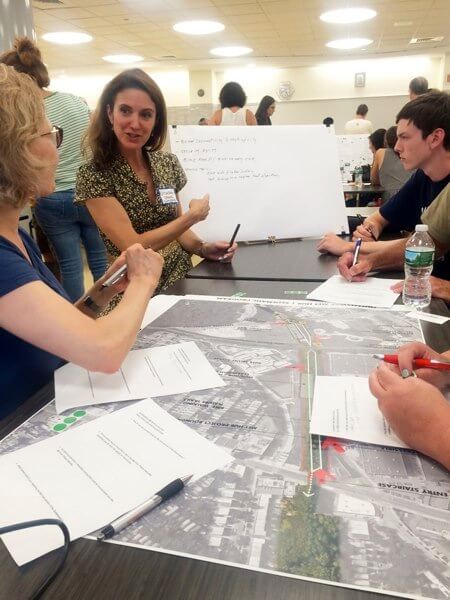By Naeisha Rose
Residents of the Central Queens advocacy group, Friends of the QueensWay, and The Trust for Public Land, a non-profit that constructs and conserves green space, held a workshop for other inhabitants to participate in the Phase One design of a pedestrian park that could cost up to $120 million.
The two organizations want to have an esplanade built where the defunct LIRR Rockaway Beach Branch line used to run.
The QueensWay Metro Hub is being proposed as a greener community and business-friendly version of the Highline in Manhattan and a respite for the 322,000-plus people who live within a mile radius, according to their estimates.
The meeting, which drew about 100 people, at first seemed like a tale of two cities, but it was actually a tale of three, if not four.
Many participants who knew of both projects wanted neither to happen. Even more people, mostly homeowners and renters who live the closest to the proposed park had no interest or knowledge of the train reactivation plans and were outright skeptical with QueensWay after learning about it up to three days ago. Still they took part in the discussion.
Andy Stone, the director of the trust, championed the QueensWay.
“There is a growing interest in linear parks, but in New York they are mainly concentrated in Manhattan and in Downtown Brooklyn,” he said. “It will be a park of the 21st century for the borough.”
The 47-acre land mass stretches 3.5 miles from the tip of the Rockaways to Rego Park. In between those neighborhoods are Forest Hills, Glendale, Richmond Hill, Woodhaven and Ozone Park.
“You would have this complete bike trail from North to South Queens and connect neighborhoods so that you can really experience the diversity of all the cultures,” said Stone.
The trust’s website claims “that everyone is on the same page,” but that is not the case for members of the Queens Public Transit Committee. Some members of the community and the Rockaways would prefer to have the old rail line reactivated rather than creating a public park along the tracks.
“If you look into the history of the rail line, it was a direct route from Penn Station to the Rockaways,” said Phil McManus, chairman of the QPTC. “Imagine if you can get a train from here to Midtown in less than 35 minutes,” said McManus. “No one is going to want to ride almost four times as long on a bike, get sweaty and then end up in need of a shower at work.”
For the students who attend the 12 schools nearby, QueensWay is being presented as a safe stomping ground.
“I love to explore places, but it is not safe,” said Elizabeth Goldstein, 14, who attends the Metropolitan Expeditionary Learning School in Forest Hills, where the meeting was held.
Travis Terry, 41, a volunteer for QueensWay, agrees with Goldstein about the beautification of that zone.
“I live here, and always noticed this abandoned structure that was a blight on our community,” said Terry, a strategic consultant who helped create the group in 2011. “I’m thinking of it as a place that we can play and have a Little League. Spiritually speaking, this is the most diverse place on the planet, and we can bring all these arts and culture activities from around the world here for everyone’s kids to our seniors.”
For McManus, the QueensRail is a quality-of-life issue for his locality.
“If you do not have a train, you can’t get anywhere, and the Rockaways is a very neglected area that is treated like a literal dump,” he said. “We are suffering from racism and classism here. They put the poor, the unskilled, the old and the mentally ill in the Rockaways and that created crime, fear, and resentment,” said McManus.
A fellow QPTC member who went to the meeting as McManus protested outside the school found QueensWay to be a ridiculous notion.
“I think it’s one of the stupidest ideas because everybody knows that Queens has no park space, right,” asked Eugene Falick, ironically. ”What Queens needs is north-south transportation, and they don’t want that,”
He doesn’t believe that QueensWay intends on making more green space.
“I asked what they are going to do for a footpath? They said they are going to pave it with permeable paving. I suggested grass, and they said the grass is terrible, so that’s the people who are doing this. They are taking a scarce resource for a park, and I don’t think that is reasonable,” Falick said.
When asked about noise pollution from QueensRail, McManus mentioned a third alternative he said he proposed to QueensWay before the proceedings. He cited the Virginia Rail Express train proposal that had a roof deck for a park on top and Gov. Andrew Cuomo’s recent smart train plans.
“If I said tomorrow we will build walls so that you won’t even feel or hear that train, they would say, oh, no, we want the park! They want the park to keep people away from South Queens,” said McManus.



































